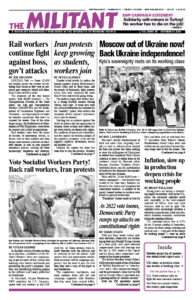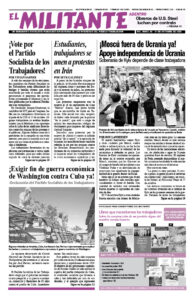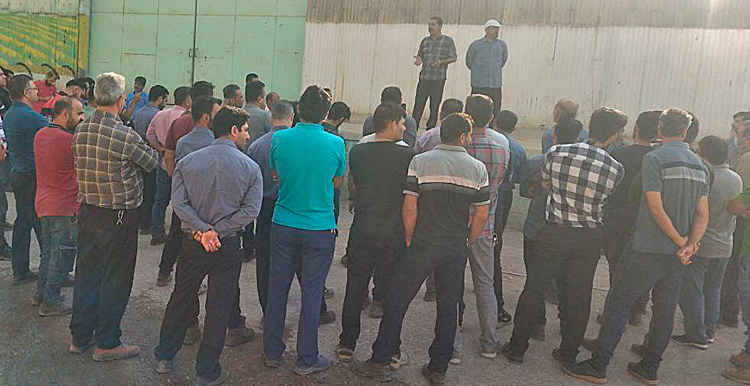Despite brutal attacks by police, the Iranian regime’s Islamic Revolutionary Guard Corps and its Basij thugs, and the arrests of thousands, daily protests across Iran have continued for more than 30 days and are still going strong.
The protests began after Mahsa Amini, a young Kurdish woman visiting Tehran, died Sept. 16 three days after she collapsed following her detention by the “morality” police, who enforce the bourgeois clerical regime’s reactionary dress code for women.
Starting out as protests against the death of Amini and the oppression of women, these actions also reflect anger over attacks on democratic rights, the condition of oppressed minorities, and the impact on working people of the capitalist economic crisis and the regime’s military adventures across the Middle East.
Nothing the regime has done has been able to stop the protests. Students frequently march through busy business districts in Tehran and other cities chanting “Freedom, freedom, freedom!” and “Down with the dictator!” as passing drivers honk their horns in support.
Tensions increased Oct. 15 after some prisoners reportedly rebelled at the notorious Evin prison in Tehran. Eight prisoners died and more than 60 were injured and part of the prison was set on fire. Thousands are held there, including recently arrested protesters and union leaders who have been imprisoned for years.
The government claims inmates jailed for theft clashed and this had nothing to do with the “protests and riots” across the country. Under pressure from family members and unionists, prison authorities allowed inmates to call their families and let them know they were OK.
According to the Free Union of Iranian Workers, a labor federation, a couple days before the clash prisoners gathered in the yard chanting slogans in solidarity with the protest movement.
Debate in Iran parliament
The Iranian parliament recently issued a report claiming the police never harmed Amini and that the cause of her death was an underlying medical condition. Anyone who says otherwise should be “prosecuted,” it declared.
According to the daily Shargh, the commander of the Tehran police wrote to parliament calling for the ouster of four of its members who criticized police conduct.
The government also denied reports that Asra Panahi, a student at the Shahid School in Ardabil — a majority Azerbaijani province in northern Iran — had died Oct. 14 after being beaten by government agents for refusing to sing a pro-regime song.
The Teachers’ Coordinating Council investigated and confirmed her death. It noted that parents rallied at the Ardabil Education Department to express their anger at the school trying to force students to attend pro-regime events.
Baluchistan, Kurdish areas attacked
In the deadliest single incident so far, police and Revolutionary Guard troops fired on protesters in Zahedan, in Sistan and Baluchistan Province, Sept. 30. The action was also fueled by reports that a teenage Baluch girl in Chabahar had been raped while in police custody in early September. Some reports say that at least 66 people were killed at the protest.
Baluchistan is one of the country’s poorest regions and the only one where the majority of people live in rural areas. Iran is home to as many as 2 million Baluch, a predominantly Sunni Muslim people who face discrimination from the Shiite-based regime in Tehran. Though less than 3% of Iran’s population, they make up 21% of those who were executed in 2021.
Rudaw news agency, based in the Kurdish region of Iraq, reports that at least 32 protesters have been killed in Iran’s neighboring Kurdish regions. It reported Oct. 18 that thousands there have been detained — often beaten — and interrogated by police and the Revolutionary Guard over the last month.
The Guard vowed to continue bombing Iraqi Kurdistan after its Kurdistan Regional Government refused demands by Tehran that it disarm Kurdish Iranian groups based there.
The Kurds are a 30-million strong oppressed nationality spread over Iraq, Iran, Syria and Turkey who have struggled for decades for their national rights. One of the most popular slogans in Iran after the death of Amini, “Woman, life, freedom,” arose out of the Kurdish struggle.
Sanandaj in Kurdish Iran “is now a military zone,” a resident of that city told the Washington Post in a voice message. “Men and women of all generations have come together here to fight for their rights that have been trampled on for 50 years. We will be on the streets until the day we find some peace from constant injustice and oppression.”
Despite bloody attacks, protests continue in the Kurdish regions.
The regime has been more cautious in its attacks in Tehran and other predominantly Shiite cities, where it has used threats, tear gas, rubber bullets and beatings more than live ammunition.
Oil workers’ union
Oil workers organized rallies Oct. 12 to demand the release of workers who had been detained after an action outside the Asalouyeh petrochemical complex in Bushehr held in solidarity with the nationwide protests. Then after the rally more workers were arrested, bringing the total to over 30. The Organizing Council of Oil Contract Workers said Oct. 17 that some have been released on bail. “Our strong emphasis is on the immediate release of all arrested workers,” the union said, while reviewing plans “to continue and expand our protests.”
On Oct. 18 workers at the Haft Tappeh sugar cane company in predominantly Arab Khuzestan went on strike. Among their demands are higher wages and the return to work of a fired union representative. The same day tanker-truck drivers refused to pick up their loads at the Abadan oil refinery in Khuzestan and blocked the entrance.
The protests are shaking the regime in Tehran. The daily newspaper World of the Economy claimed that rumors that the hated “morality” police were back on the streets — after the regime pulled them back in the face of the protests — were “a fabrication.”
Despite the regime’s shutdown of much of the country’s internet, opponents still get videos and news out to the world every day.
Several dozen Iranians living in Kyiv protested outside the Iranian Embassy there Sept. 30, condemning both the crackdown in Iran and Tehran’s supplying of drones to Moscow for its war against the Ukrainian people. Somi, an Iranian student who would only give her first name, told the press that she wants “the world to know that this government does not represent the wishes of the Iranian people.”


